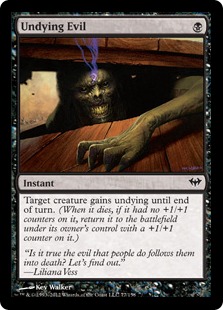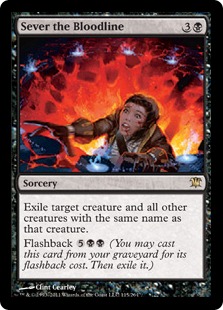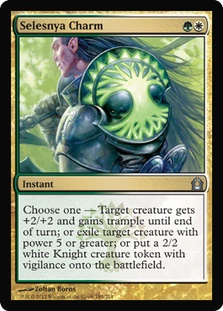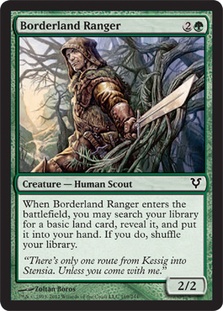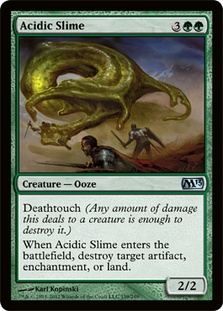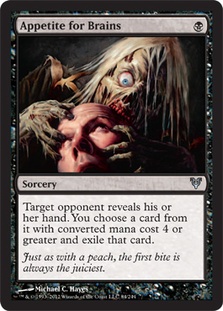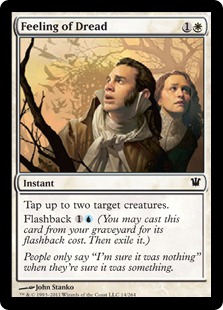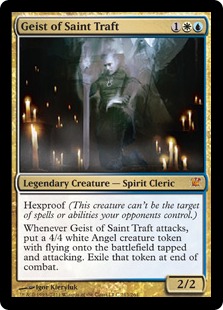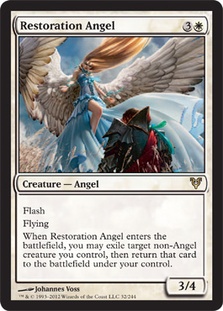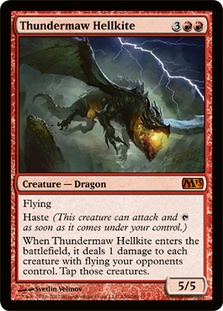Innistrad-Gatecrash Standard has proven itself very interesting and, maybe even more importantly, breakable by those who really want it (his name is Brad Nelson if you want to know). Dragon’s Maze will come soon and hopefully add even more fun, but current Standard is at its peak right now: the SCG Invitational in Atlanta is this weekend. G/W/B Reanimator is still the best deck, and its presence forces the adaptation of every other archetype—and Reanimator itself is adapting too! It’s one of the most interesting processes in Magic, and its investigation is one of the most entertaining things in this game.
Let’s look at the six Reanimator decks in the Top 16 if the Saturday Standard Open in Orlando (this weekend featured two Standard Opens, but the results of the second one were unavailable when I was writing this article). Four of the six decks feature maindeck hate cards for the mirror match. Deathrite Shaman is the most common (and is a popular sideboard card), but some spicy technology is here too.
Undying Evil is a cheap way to surpass removal and is fine at every stage of the game, especially against midrange decks. Selesnya Charm is a way to gain an edge in the Reanimator mirror by breaking endless chains of Angel of Serenity from both sides. The winner is usually the player who casts last Angel, and hiding the opposing one with your copy is common, so Sever the Bloodline and Selesnya Charm are great for mirror since they allow excluding an opponent’s creature from the chain. Sever the Bloodline’s advantage is reusability, while Selesnya Charm is a cheap instant, allowing a faster comeback and winning the direct competition between Angels.
The last mode of Selesnya Charm is the creation of a cheap blocker; it makes the card a potent maindeck solution for Reanimator, even if a 2/2 is much worse than opposing 3/3 creatures (at least until Jund Aggro pilots are not playing Gore-House Chainwalker over Mogg Flunkies). Selesnya Charm upgrades the early game against aggressive decks and gives an edge in the mirror match, including some chances in otherwise hopeless situations involving a fast Craterhoof Behemoth. However, direct competitors of Selesnya Charm are Abrupt Decay and Orzhov Charm, and, unfortunately for my long-time favorite cards, they both kill Deathrite Shaman and Somberwald Sage, who are invulnerable to the green-white one.
Deathrite Shaman is the most common maindeck hate card in G/W/B Reanimator and some other decks (like Jund Aggro), but I actually dislike him in the format’s boogeyman. Mana acceleration is crucial in any non-mirror match, and I’d rather have a better game 1 there and more hate in the sideboard. I lost enough games due to having one less mana than needed. Somberwald Sage is a high risk-high reward card, but she helps gain an edge in the mirror, so I’m happy to play her over Arbor Elf. However, it’s hard to justify four Sages without Lotleth Troll; the mana curve is denser at three mana, and it’s impossible to utilize multiples from a starting hand.
You may have noticed that recent tournament winners Mike Krasnitski and Dmitriy Butakov played with very simple builds without many useful maindeck singletons like Obzedat, Ghost Council, Acidic Slime, Sever the Bloodline, etc. I totally share their opinion and dislike Troll, but it’s probably time to use him, which makes my take on adapted G/W/B Reanimator the following:
Creatures (26)
- 2 Borderland Ranger
- 1 Arbor Elf
- 3 Avacyn's Pilgrim
- 3 Restoration Angel
- 2 Craterhoof Behemoth
- 4 Somberwald Sage
- 4 Thragtusk
- 2 Lotleth Troll
- 3 Angel of Serenity
- 2 Centaur Healer
Lands (19)
Spells (15)

Borderland Ranger adds a lot to the deck, helping in many tough situations; he’s not as good with Restoration Angel as Thragtusk is, but Ranger is usually better target than Centaur Healer. The rest of the deck is more or less common with sideboard cards distributed among the most relevant matches. I’m playing only one Rhox Faithmender since aggressive decks are on the clean decline now, so I have the full four Acidic Slimes, which are great against any slow deck. Midrange decks seems to oust aggression from the metagame at least partially, and Acidic Slime is a fine way to keep control in check.
Midrange decks are in a strange position now. They aren’t great against Reanimator but devastate aggressive decks, which were on the rise as level one hate to the best deck. However, while Magic Online is still full of Mono-Red Aggro, there were only three aggro decks in the Top 16 of the Saturday Open in Orlando, and Jund seems less and less appealing among all this Reanimator and Esper Control. Esper pilots have found a more or less working solution against Reanimator, ousting U/W/R from the metagame and putting Jund exactly between Scylla and Charybdis. A high presence of aggro would nevertheless justify it, but I think that Jund is unfortunately just a wrong choice right now. I’d rather set on Jund Aggro as the most potent and reliable choice among aggro decks.
Creatures (28)
- 4 Strangleroot Geist
- 1 Falkenrath Aristocrat
- 4 Hellrider
- 1 Thundermaw Hellkite
- 3 Flinthoof Boar
- 4 Dreg Mangler
- 4 Deathrite Shaman
- 3 Experiment One
- 4 Ghor-Clan Rampager
Lands (20)
Spells (12)

Looking at Samuel Williams’ Jund Aggro, one may notice the full circle: Jund Aggro started with Deathrite Shaman and Hellrider many weeks ago, and they’re here again. Deathrite Shaman is a reliable mana dork against Reanimator, which compensates his bad attacking stats. He’s also good against control, which makes him perfect in aggro-light metagame. Again, note that the Magic Online metagame is different—and the metagame of your local PTQ may be different too.
As for the SCG Opens in Orlando (and probably the Invitational in Atlanta), I highly appreciate this build of Jund Aggro, including details like maindeck Appetite for Brains (great at beating both Angel of Serenity and Supreme Verdict). If Esper Control’s presence grows even heavier, Jund Aggro may transform into Zombies, as Geralf’s Messenger is a great way to beat Supreme Verdict. However, Zombies isn’t that great against Reanimator, so it’s probably not the right call at the moment.
Another interesting point and mark of difference between the SCG Open and Magic Online metagame is the Bant Hexproof deck. It was said to be well positioned for a comeback and posted some good results on Magic Online. The deck is surely great against Reanimator (I never saw such a sad Angel of Serenity) and decks like Jund, but Supreme Verdict is painful and there will surely be some hate next week. So while Magic Online is still friendly for the deck, the SCG Open circuit is probably not, and I’d rather stay away from the deck.
Hugo Terra, however, presented a very interesting take. His Top 16 deck combines Bant Hexproof with some very aggressive creatures. It’s not my ideal since I dislike having two half-working plans instead of one focused plan, but it at least partially solves Bant Hexproof’s intrinsic instability and allows it to deal enough damage before Supreme Verdict to make recovery easy enough.
Creatures (24)
- 4 Invisible Stalker
- 4 Champion of the Parish
- 4 Avacyn's Pilgrim
- 4 Geist of Saint Traft
- 4 Silverblade Paladin
- 4 Boros Elite
Lands (20)
Spells (16)
Sideboard

Hugo’s sideboard is enchantment-heavy, which I believe to be a mistake, especially as I generally dislike expensive hate cards in aggressive decks. However, Champion of the Parish and Boros Elite may allow generating enough pressure to spend turn 3 or 4 on Rest in Peace or Nevermore.
Hugo’s choice of removal is also worth mentioning: Selesnya Charm and Feeling of Dread. I’d certainly be happy with this set, but the lack of Simic Charm is frustrating. It’s devastating to lose early creatures to removal, while Simic Charm is especially priceless at beating an early Angel of Serenity from Somberwald Sage.
I’m trying different decks now, and the uncertainty of the metagame is hard to adapt for. I think a classic aggro deck (see Jund Aggro above) would be good for the SCG Invitational Atlanta, but the delayed and more aggressive local metagame I expect to face in Moscow is much friendlier for Bant Hexproof. I’d stick to something different on Magic Online right now (keeping it in mind for the local metagame). The most interesting deck for Magic Online is still Peddle to Metal, which I mentioned in my previous article. The SCG Open metagame is probably past the point where Nightshade Peddler and Ethereal Armor are good, but they’re still fine for other purposes—which is why I especially enjoy Lewis Laskin take on Peddler.
Creatures (23)
- 3 Huntmaster of the Fells
- 2 Restoration Angel
- 4 Nightshade Peddler
- 1 Angel of Glory's Rise
- 4 Thragtusk
- 1 Thundermaw Hellkite
- 4 Izzet Staticaster
- 4 Boros Reckoner
Lands (25)
Spells (12)

That’s his list from a Magic Online Daily Event, and I hope that his deck tech will be on SCG Orlando coverage by the time this article is posted. In my opinion, exchanging black for white is very interesting as it makes you faster against aggressive decks (Boros Reckoner is almost as good as Olivia Voldaren is but is at least a turn faster) and gives you great sideboard options for matches where the combo is sided out.
The combination of Geist of Saint Traft, Huntmaster of the Fells, Restoration Angel, Thundermaw Hellkite, and Thragtusk is a good way to beat control. With literally every creature being troublesome, it’s much easier to force control to spend sweepers unprofitably and win. Even if Lewis didn’t do well in Orlando, his deck deserves attention, especially if you expect an aggressive metagame at the tournament you’re planning to attend this weekend.

